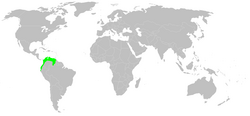Biology:Brugmansia aurea
| Brugmansia aurea | |
|---|---|

| |
| Scientific classification | |
| Kingdom: | Plantae |
| Clade: | Tracheophytes |
| Clade: | Angiosperms |
| Clade: | Eudicots |
| Clade: | Asterids |
| Order: | Solanales |
| Family: | Solanaceae |
| Genus: | Brugmansia |
| Species: | B. aurea
|
| Binomial name | |
| Brugmansia aurea Lagerh.
| |

| |
| Synonyms | |
|
Brugmansia pittieri | |
Brugmansia aurea, the golden angel's trumpet, is a species of flowering plant in the nightshade family Solanaceae, endemic to Ecuador. Since March 2014, it has been listed as Extinct in the Wild by the IUCN but before that, it was listed as Vulnerable.[1]
Despite being declared extinct in its native range, Brugmansia aurea is a popular ornamental and is widely cultivated, like the other members of its genus. It is sold and grown as a garden plant, described as a large evergreen subtropical shrub capable of growing to 20 ft (6.1 m) in height. The large, pendent, trumpet-shaped yellow or white blooms appear in summer and autumn in the Northern Hemisphere. These flowers produce a sweet and pleasant fragrance, which is at its strongest in the evening.[2]
Etymology
The Latin specific epithet aurea means "golden".[3]
Cultivation
Several cultivars exist, notably 'Grand Marnier' with peach-coloured flowers. As with other members of its genus, it cannot handle temperatures below 5 °C (41 °F), but in colder climates can be placed outside in a sheltered spot during the summer months.[4][5]
Synonyms
- Brugmansia affinis
- Datura aurea
- Datura affinis
Toxicity
All parts of the plant are poisonous.[6]
Uses
It is used as a hallucinogen. Its most potent cultivar is Culebra Borrachero, which has a high concentration of the psychoactive scopolamine.[7] It has also been used as a truth serum.[8] Borrachero loosely translates to "get-you-drunk", and scopolamine is also known as Devil's Breath[9] and burundanga.[10]
References
| Wikimedia Commons has media related to Brugmansia aurea. |
- ↑ 1.0 1.1 Hay, A. (2014). "Brugmansia aurea". IUCN Red List of Threatened Species 2014: e.T38124A58906215. doi:10.2305/IUCN.UK.2014-1.RLTS.T38124A58906215.en. https://www.iucnredlist.org/species/38124/58906215. Retrieved 15 November 2021.
- ↑ "12 plants for evening scent". https://www.gardenersworld.com/plants/plants-for-evening-scent/. Retrieved 12 July 2019.
- ↑ Harrison, Lorraine (2012). RHS Latin for Gardeners. United Kingdom: Mitchell Beazley. ISBN 978-1845337315.
- ↑ "Brugmansia aurea 'Grand Marnier'". RHS. https://www.rhs.org.uk/plants/115966/brugmansia-aurea-grand-marnier/details.
- ↑ "Angel’s Trumpet, Brugmansia" (in en-US). https://hort.extension.wisc.edu/articles/angels-trumpet-brugmansia/.
- ↑ "Angel's Trumpet," The Better Homes and Gardens Plant Encyclopedia.
- ↑ Pratt, Christina (2007). "Brugmansia Aurea". An Encyclopedia of Shamanism. Rosen Publishing. pp. 68–70. ISBN 978-1-4042-1040-0. https://books.google.com/books?id=HltJMMq1_60C&pg=PA68.
- ↑ House, Robert E. (1931). "The Use of Scopolamine in Criminology". The American Journal of Police Science 2 (4): 328–336. doi:10.2307/1147361. ISSN 1547-6154. https://www.jstor.org/stable/1147361.
- ↑ Draper, Lucy (2015-09-03). "Does the 'Devil's Breath' Drug Really Exist?". Newsweek. http://europe.newsweek.com/does-devils-breath-drug-really-exist-332465. Retrieved 2017-04-13.
- ↑ Cotroneo, Christian (2013-09-03). "The World's Scariest Drug". The Huffington Post. http://www.huffingtonpost.ca/2013/09/03/devils-breath-scopolamine_n_3860318.html. Retrieved 2017-04-13.
Wikidata ☰ Q1937684 entry
 |



